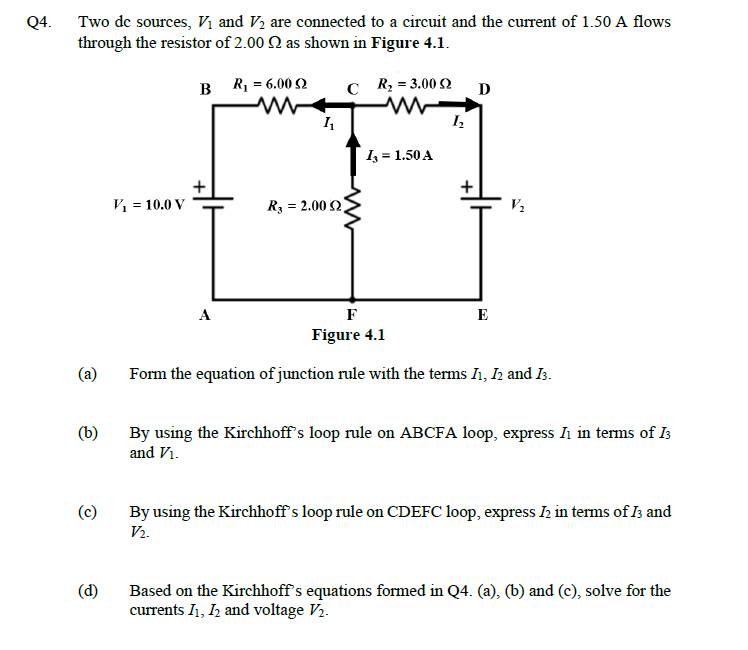Q4. Two de sources, Vị and V2 are connected to a circuit and the current of 1.50 A flows through the resistor of 2.00 Q as shown in Figure 4.1. B R, = 6.00 2 C R2 = 3.00 Q D Iz = 1.50 A V = 10.0 V R3 = 2.00 2 V2 A F E Figure 4.1 (a) Form the equation of junction rule with the terms I, I and Is. (b) By using the Kirchhoff's loop rule on ABCFA loop, express h in terms of Is and Vi. By using the Kirchhoff's loop rule on CDEFC loop, express In in terms of I; and V2. (d) Based on the Kirchhoff's equations formed in Q4. (a), (b) and (c), solve for the currents I1, Ih and voltage V2.
Q4. Two de sources, Vị and V2 are connected to a circuit and the current of 1.50 A flows through the resistor of 2.00 Q as shown in Figure 4.1. B R, = 6.00 2 C R2 = 3.00 Q D Iz = 1.50 A V = 10.0 V R3 = 2.00 2 V2 A F E Figure 4.1 (a) Form the equation of junction rule with the terms I, I and Is. (b) By using the Kirchhoff's loop rule on ABCFA loop, express h in terms of Is and Vi. By using the Kirchhoff's loop rule on CDEFC loop, express In in terms of I; and V2. (d) Based on the Kirchhoff's equations formed in Q4. (a), (b) and (c), solve for the currents I1, Ih and voltage V2.
Delmar's Standard Textbook Of Electricity
7th Edition
ISBN:9781337900348
Author:Stephen L. Herman
Publisher:Stephen L. Herman
Chapter29: Dc Generators
Section: Chapter Questions
Problem 1PA: You are working as an electrician in a large steel manufacturing plant, and you are in the process...
Related questions
Question

Transcribed Image Text:Two de sources, Vị and V2 are connected to a circuit and the current of 1.50 A flows
through the resistor of 2.00 Q as shown in Figure 4.1.
Q4.
B R, = 6.00 2
C R2 = 3.00 Q
D
I
Iz = 1.50 A
V = 10.0 V
R3 = 2.00 2
A
F
E
Figure 4.1
(a)
Form the equation of junction rule with the terms I, Ih and Is.
(b)
By using the Kirchhoff's loop rule on ABCFA loop, express Ii in terms of Is
and V1.
(c)
By using the Kirchhoff's loop rule on CDEFC loop, express In in terms of I; and
V2.
(d)
Based on the Kirchhoff's equations formed in Q4. (a), (b) and (c), solve for the
currents I1, h and voltage V2.
Expert Solution
This question has been solved!
Explore an expertly crafted, step-by-step solution for a thorough understanding of key concepts.
Step by step
Solved in 2 steps with 1 images

Knowledge Booster
Learn more about
Need a deep-dive on the concept behind this application? Look no further. Learn more about this topic, electrical-engineering and related others by exploring similar questions and additional content below.Recommended textbooks for you

Delmar's Standard Textbook Of Electricity
Electrical Engineering
ISBN:
9781337900348
Author:
Stephen L. Herman
Publisher:
Cengage Learning

Delmar's Standard Textbook Of Electricity
Electrical Engineering
ISBN:
9781337900348
Author:
Stephen L. Herman
Publisher:
Cengage Learning